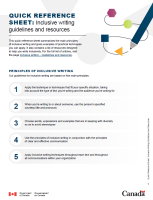Section: Inclusive writing
Go to the main page of this section: Inclusive writing – Guidelines and resources.
This quick reference sheet summarizes the main principles of inclusive writing and gives examples of practical techniques you can apply. It also contains a list of resources designed to help you write inclusively.
On this page
- Principles of inclusive writing
- Gender-inclusive writing techniques
- Representation of non-binary gender
- Resources for inclusive and respectful language
- Printable PDF version of the quick reference sheet
- Additional information
Principles of inclusive writing
Our guidelines for inclusive writing are based on five main principles.
- Apply the technique or techniques that fit your specific situation, taking into account the type of text you’re writing and the audience you’re writing for.
- When you’re writing to or about someone, use the person’s specified courtesy title and pronouns.
- Choose words, expressions and examples that are in keeping with diversity so as to avoid stereotypes.
- Use the principles of inclusive writing in conjunction with the principles of clear and effective communication.
- Apply inclusive writing techniques throughout each text and throughout all communications within your organization.
Gender-inclusive writing techniques
Use the techniques outlined below to write gender-inclusively.
| Technique | Examples |
|---|---|
| Replace gendered occupational titles |
|
| Replace expressions containing “man” or “woman” |
|
| Replace gendered terms denoting relationships (in general contexts or in cases where gender is unknown) |
|
| Technique | Examples |
|---|---|
| Pluralize the noun |
|
| Use the singular “they” |
|
| Use an article |
|
| Omit the pronoun |
|
| Repeat the noun |
|
| Address the reader directly |
|
| Use the imperative |
|
| Use the pronoun “who” |
|
| Use the pronoun “one” |
|
| Use the passive voice |
|
| Use sentence fragments |
|
| Rewrite the sentence |
|
| Parts of the letter or email | Examples |
|---|---|
| Inside address (if receiver’s gender or courtesy title is unknown) |
|
| Salutation (if receiver’s gender or courtesy title is unknown) |
|
| Context | Examples |
|---|---|
| Tailoring to recipients who are non-binary | Use the person’s specified courtesy title if you know it; for example:
|
Representation of non-binary gender
Members of gender-diverse communities have put forward various techniques for writing English texts that correspond to their realities. Since individual usage varies, it's important to respect each person’s wishes with regard to pronouns and courtesy titles.
| Issue | Recommendations |
|---|---|
| Pronouns and neopronouns | When writing about a non-binary individual, use the person’s specified pronoun:
|
| Gender-inclusive courtesy titles | When writing to or about a non-binary individual,
|
| Gender-inclusive nouns | When writing about a non-binary person, use terms that are gender-inclusive:
|
| Issue | Recommendations and examples |
|---|---|
| Translating the French pronoun “iel” | When translating the pronoun “iel,”
|
| Translating other gender-inclusive text | When translating a text about a non-binary individual whose gender is unclear,
|
Resources for inclusive and respectful language
The resources below will help you find the right words to write inclusively and respectfully.
| Title | Description |
|---|---|
| Inclusionary: A collection of gender-inclusive solutions | A collection of gender-inclusive alternatives to gendered words and expressions. |
| Guide on Equity, Diversity and Inclusion Terminology | A bilingual guide designed to promote an understanding of concepts related to equity, diversity, accessibility and inclusion. |
| Accessibility Glossary | A glossary containing 342 concepts in the fields of accessibility, sociology of work and technical aids for persons with disabilities. |
| Gender and Sexual Diversity Glossary | A glossary containing 193 concepts related to gender and sexual diversity. |
Printable PDF version of the quick reference sheet
Additional information
Copyright notice for Writing Tips Plus
© His Majesty the King in Right of Canada, represented by the Minister of Public Services and Procurement
A tool created and made available online by the Translation Bureau, Public Services and Procurement Canada
Search by related themes
Want to learn more about a theme discussed on this page? Click on a link below to see all the pages on the Language Portal of Canada that relate to the theme you selected. The search results will be displayed in Language Navigator.
Related links
- Writing Tips Plus (home page)
- Writing tools
- Language Navigator (for fast access to language tips)
- TERMIUM Plus®
